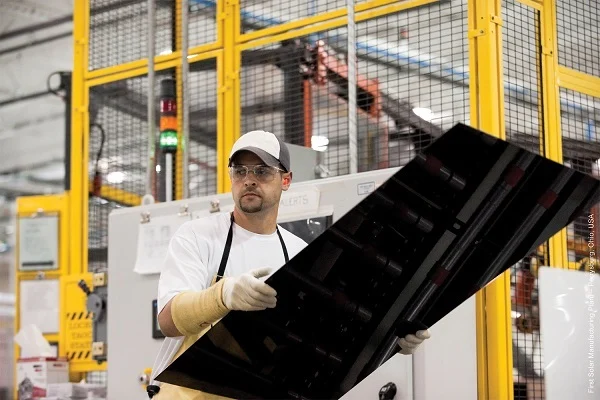First Solar is apparently inching toward manufacturing some silicon solar products, but that doesn’t mean the company’s bread and butter, cadmium-telluride (CdTe) cells, are taking a back seat. Not if this news is any indication: a new CdTe cell conversion record of 20.4 percent.
This beats the old world record of 19.6 by GE Global Research last year – and what do you know, it was last year that GE sold its own thin-film technology to First Solar and partnered with First Solar on solar R&D.

Manufacturing plant in Perrysburg, Ohio (image via First Solar)
“We are demonstrating improvement in CdTe PV performance at a rate that dramatically outstrips the trajectory of conventional silicon technologies, which have already plateaued near their ultimate entitlements,” First Solar CTO Raffi Garabedian said in a statement. “The synergy realized in our partnership with GE also demonstrates the value of our consistent and strong investment in R&D. The advanced technologies and processes we developed for this record-setting cell are already being commercialized and will positively impact performance of our future production modules and power plants.”
Now, just to review a bit: The solar efficiency of a photovoltaic cell indicates how much of the light hitting it is converted to power. Measurements are done in the lab and verified and tracked by the National Renewable Energy Lab in several categories and subcategories depending on the architecture of and materials used in the cell. (You can see the NREL chart here.)
Cell efficiency is obviously important, but it shouldn’t be misconstrued as real-world module efficiency; if you put some of First Solar’s thin-film panels on your roof (or, more likely, used them in a utility-scale array, First Solar’s specialty), they wouldn’t churn out power at a 20 percent efficiency rate even in the best of sun conditions.
Still, the yield of the panels does track with the improving cell efficiency; a year ago when First Solar announced it had set a CdTe record of 18.7 percent, it said its average production module efficiency was at 12.9, up 0.7 percentage points from 2011. Now, that average production model efficiency is up to 13.4 percent. Pair that with falling manufacturing costs – from $0.64 a watt in late 2012 to $0.53/watt now, First Solar says – and it’s pretty clear why solar is becoming more and more economically viable.






